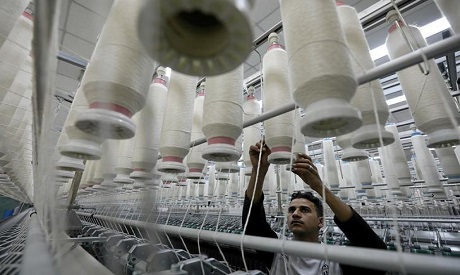
A factory worker works at a spinning factory on the outskirts of Cairo, Egypt, January 30, 2017 (Photo: Reuters)
The idea of industrial cities began in the early 1970s, with Al-Sadat, 10 Ramadan and 6 October City being built during the last years of the rule of former president Anwar Al-Sadat. The aim was to build integrated industrial zones that would contribute to the country’s overall gross domestic product.
This strategy has shifted over the past two years, however, from establishing industrial cities to complexes that host a single industrial activity. These started with a plastic manufacturing complex in Margham in Alexandria, a furniture city in Damietta, and a textiles complex in Al-Sadat City. The latter hosts 568 textiles plants with investment exceeding $2.2 billion and annual production worth more than $9 billion. It is expected to provide all services related to the textiles industry, including a state-of-the-art training faculty, and to generate 160,000 job opportunities.
In the pipeline is the building of a new industrial zone in Kom Oshim in Fayoum of over 33 million square metres, as per an agreement between the Ministry of Trade and Industry and a Singapore holding company. According to a ministry statement, the new city, which will be linked to Cairo via the new Regional Ring Road, will host “giant industrial projects and will be equipped with the most technologically advanced systems. Residential units, schools and hospitals will also be built in the city to help alleviate congestion in Cairo.”
“Upper Egypt is home to 37 per cent of industrial zones in the country, with investments worth LE75 billion. With 50 industrial complexes out of a total of 114 nationwide, what Upper Egypt lacks is a strong, functioning infrastructure,” said Tarek Kabil, the minister of trade and industry.
A ministry source, who preferred to remain anonymous, told Al-Ahram Weekly that “industrial clusters help increase the overall growth rate and the added value of each industry.”
After the 25 January Revolution, industrial activities saw setbacks, especially in land allocation. According to one official at the Ministry of Trade and Industry, it was the New Urban Communities Authority, not the Industrial Development Authority (IDA), that assigned lands to industrial projects, resulting in overpricing.
Over the past few years the ministry has used a new system that allows companies to administer, develop and provide facilities to industrial zones through international tenders in order to overcome the problem of land scarcity. “Industries need more than seven million square metres annually. The state provides no more than three million,” the IDA website says. The ministry official told the Weekly that “the IDA has resorted to selling land complete with facilities or via the industrial-developer system for cash or through installments on condition that it dictates profit margins per square metre.”
“The merit of the industrial-developer system is that it provides facilities and marketing services and builds plants according to the needs of the property holder,” he continued. “The ministry is currently establishing industrial complexes that cater to small and medium-sized projects, providing small industrial units of 300-600 square metres in size with a cheaper renting system and up to a 50-year usufruct.”
Earlier this month, parliament approved a law that grants the IDA more independence. State land allocated for industrial purposes now falls under the jurisdiction of the IDA, and administratively it is free to decide its own human-resources regulations outside usual public-sector rules, in order to give it the necessary expertise and increase the quality of its work.
The authority’s budget will be monitored by the Central Auditing Authority. “The law allows the IDA to freely decide the price of industrial properties. Currently, industrial plots are either sold through the New Urban Communities Authority or the governorates to which land is affiliated. Under the new law, the IDA will buy land from the New Urban Communities Authority and sell it to investors. Land owned by the governorates will be taken by the IDA to provide with facilities before selling to investors,” the ministry source said.
According to Kabil, “the IDA has sold 28.5 million square metres of land to local and foreign investors over the past two years. This is anticipated to attract LE42 billion worth of investment after building factories and the start of production.”
The state expects the industrial zones to reach 60 million square metres by 2020.
* This story was first published in Al-Ahram Weekly
Short link: